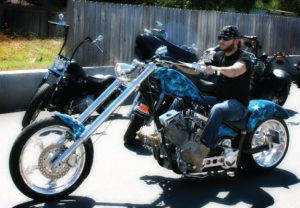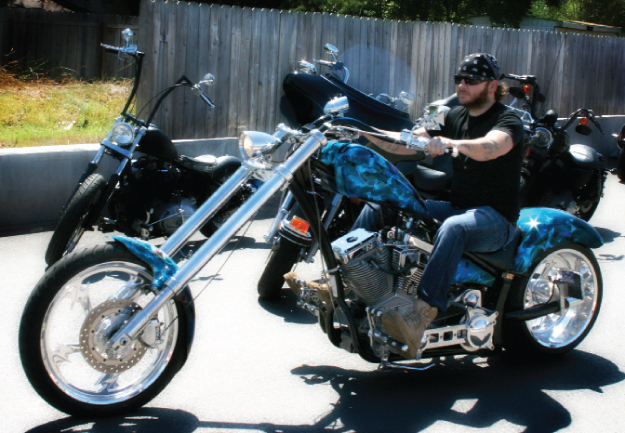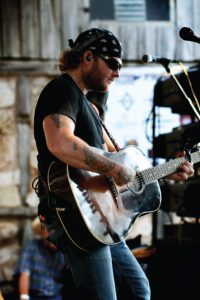By Kathleen O’Keefe
(Nov/Dec 2011/Vol. 4 – Issue 6)
It’s been nearly a decade since Stoney LaRue released his first (now out of print) CD, Downtown, which was recorded live at Cain’s Ballroom in Tulsa and mixed in a trailer on a bluff outside of Bartlesville, Okla. At the time, LaRue had been honing his skills on the Stillwater music scene, communing with Red Dirt stalwarts like Bob Childers, Randy Crouch, Cody Canada, Jason Boland, and the Red Dirt Rangers, to name a few. He’s part of the “Yellow House” mythology, a place of legend and lore where several top Red Dirt artists lived and collaborated early in their careers.
Born in Taft, Texas, and raised by his grandparents in southeastern Oklahoma, LaRue was influenced not just by country music, but by a range of artists from Bob Dylan to Ray Charles. Music is in LaRue’s DNA; his father was a bass player, and he recently learned there was a family band on his mom’s side. He recorded his first works at age 12, and earned accolades for his natural abilities until he made his way to the musical hotbed of Stillwater and furthered his talents.
LaRue became renowned as an incredible vocalist and player, exuding a biker-infused charm and a barroom brand of spirituality while creating and performing his melodic, bluesy blend of country. His first studio release, The Red Dirt Album (2005), garnered industry praise and a loyal fanbase for the rising songwriter, who at the time was mostly playing without a full band. By 2007’s Live at Billy Bob’s, he was running at full throttle. “That was like jumping straight into the fire,” LaRue says of the live album. “Two weeks after putting the band together, we recorded the album, hit the road and did 250 dates a year. We never looked back.”
Mattson Rainer, program director for New Braunfels’ award-winning Americana Station KNBT-FM, readily recalls the day he met LaRue. “It was at a burger joint in New Braunfels,” says Rainer. “I had just been turned onto Stoney and the Organic Boogie Band and the song, ‘Downtown.’ While Stoney may consider that first CD somewhat of a demo, I fell in love with his vocals immediately. I walked over to him and said ‘You, my friend, are the second coming of The Band and the Allman Brothers rolled into one.’ That was 10 years ago. I haven’t changed my mind. Stoney sings onstage the way I think I sing in the shower. I pretend to sing like Otis Redding but Stoney doesn’t have to pretend anything. He is the real deal.”
LaRue now tours constantly, playing upwards of 300 days a year, and has amassed nearly 130,000 Facebook fans from around the globe. But for fans who came on board with The Red Dirt Album or even earlier, the wait for a new studio album from LaRue was a test of both faith and endurance. Their patience was finally rewarded with the August release of Velvet, one of the most anticipated Texas/Red Dirt scene albums of the year — if not the last six years. Not surprisingly, it was a strong seller right out of the gate, with celebrity fans like Lee Ann Womack and Gary Allan singing its praises on Twitter and the lead single title track topping the regional music charts immediately.
It definitely wasn’t a rush job. LaRue recorded Velvet in Nashville over a three-year period, enlisting the help of award-winning producers Frank Liddell (Womack, Chris Knight, Miranda Lambert,) and Mike McCarthy (Spoon, Patty Griffin). An amazing roster of musicians gathered in the studio (Ben Folds’ studio, to be precise), among them Randy Scruggs on acoustic guitar, Chad Cromwell on drums, Glen Duncan on fiddle, and Glenn Worf on bass. Ian McLagan contributes keys on a couple of tunes. Womack also graces Velvet with her vocal harmonies, as does her daughter, Aubrie Sellers.
Of the 10 songs that comprise the album, all but one were co-written with Mando Saenz, a songwriter’s-songwriter born in San Luis Potosi, Mexico. The one exception is a tune called “Wiregrass,” which LaRue co-wrote with Alabama native Adam Hood.
LaRue had a stockpile of material to work with, but the songs he co-wrote with Saenz really resonated and expanded his horizons at the time, both personally and professionally.
“I had about 20 or 25 songs ready,” LaRue says. “I had written some with Brandon Jenkins, a couple with Jason Boland. I went to meet Frank in Nashville, and he introduced me to Mando Saenz about two years ago. Mando came out with me a few times. We just wanted to see what it was like, if it was going to vibe, and the first song we came out with was ‘Velvet.’ We thought, ‘hey we can vibe this.’ We built some songs together, and we still have more than we recorded.
“The experience was really cool, to open up the mind and not rely on consistency,” he continues, then adds with a laugh, “to, how would you say, open your consciousness.”
Velvet boasts songs that reflect a mellower LaRue, and also a notable departure in his approach, as evidenced in the standout track, “Te Amo Mas Que La Vida” and the record’s varied instrumentation.
“It wasn’t really like anything I’ve ever done before,” he says. “Everything really came all at once. It wasn’t just sitting down and writing with Mando, it was the lining up of a lot of things in the universe. From personal issues, to what my actual goals are as a man, as a father, as a husband, as a musician. It was the lining up of all of those things in my awareness, too. It’s like asking the universe, or God, or whatever you conceive Him or It to be — what the answer is. Trying to find the answers, you have to have the willingness to ask.”
LaRue says this was also the first time where he really gave the reins over to the producers’ vision. Their guidance, he insists, made it “the most organic, comfortable, recording experience in my career thus far, and the coolest at this level. … We all sat around in a big circle, just like the pictures in the insert of the CD. We would do one, two, three takes, and move on. We added some vocals in, but we did everything organically just like that, and it worked really well. Some of these guys haven’t recorded like that, on 2-inch analog tape — old school — since the ’70s. Of course I was born in the ’70s, so I haven’t done it that way since, well, ever.
“These songs had never had any music behind them before, so I didn’t have a pre-conceived notion of how they should be,” he continues. “I loved the whole experience and how everyone at one time gave everything to that moment. I saw the smiles on faces and felt the energy there, and I don’t think it would’ve been the same if we did it any other way.”
When I point out the apparent irony that he went to “Music City, U.S.A.” to make a record of live “one takes” (not exactly the music-making process most folks associate with Nashville these days), LaRue is quick to point out that there’s a lot more to Nashville than many give it credit for.
“There are a lot of amazing things that happen in Nashville,” he says. “A lot of the reason people may think certain things, about anything — I don’t care if it’s Nashville or broccoli — it’s because of ignorance. There are different ways to cook broccoli besides just steaming it and putting it on your plate. Because have you ever covered it in cheddar? It’s pretty fucking delicious. If you let go of all the ignorance and draw your own conclusions, that’s how you can have a unique experience in this existence between life and death.”
LaRue also downplays the notion that, given the long gap between albums, the making of Velvet must have been fraught with pressure and stressful expectations. “I have a hard time buying into the whole pressure thing, and what everybody else wants,” he says. “I love my fans, and if not for them I wouldn’t be in the wonderful position that I am, but by no means am I sitting there basing my next move off of what the public thinks I should do. I think it came out at just the right time, exactly the way it was supposed to. It couldn’t have happened any other way. I knew when I was ready, I would put something out. But I do know my next project will not take six years, I can tell you that. It’s like somebody turned on a switch, and it’s glowing right now. I’ve already got enough songs for two more albums. It just comes when it comes.”
As for any critics — or more likely, stubborn fans — that might say “this CD is different than the old Stoney,” well yes, it is. The songs reveal a new depth and height in experience and wisdom, laden with poetry and well-crafted imagery. The lyrics are all open to interpretation, as these are not necessarily spell-it-out-for-you songs; they are real, honest, personal songs that invite fans to draw their own conclusions for a reason.
“I just want people to feel it,” LaRue says. “That sounds like a cop out, but I really mean it. I’m looking for people’s feedback, but not to explain it to them. Everyone keeps asking, ‘What does “Velvet” mean? What does this song mean?’ I want them to know they have the capacity to figure it out what it means to them. There’s an awareness shift happening. It seems pretty obvious to me, I think it seems obvious to a lot of people. I don’t know how to explain it any other way.”
When he’s not touring with his band (which includes Alan Orebough on guitar, Casey Twist on bass, and Jeremy Bryant on drums), LaRue lives in Edmond, Okla., and spends time with his family and dogs. And he still spends quite a bit of time in Stillwater. With his inspiring harvest of new songs leading him into a new era, LaRue now looks forward to what comes next for him, as both an artist and a man.
“I know what I’d like to happen,” he says. “I’m looking forward to owning a ranch and some horses, so my kids can be outside and not in front of that damned television watching shit. I want them to feed a horse’s mouth, and to be happy and healthy. I want to spend time on my ranch with my wife and family.”
One definitely gets the sense that LaRue has grown in his journey as an artist and also learned a lot about spirituality in the last six years, even mentioning the “God Molecule” at one point. This poignant and introspective shift is salient all the way through Velvet.

Stoney rode his custom Demented Cycles chopper in the “Ridin’ for a Reason” event in September, helping to raise more than $30,000 for the Leukemia & Lymphoma Society. (Photo by Melissa Webb)
“You are what you believe you are,” he says simply. “I believe I’m a musician, and I believe I have something to offer the world. For me, it wasn’t being a lumberjack. It wasn’t working on air conditioners. It wasn’t being a military man. It was music, and it still is. I’ve done it longer than I haven’t done it, so it’s definitely part of me. I’m not a kid traveling out to get shit-railed and play music just to play music anymore, you know? There was a time that I loved being that rebel youth, but now I guess I’m a little more directed.”







No Comment